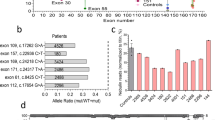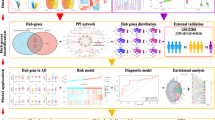Abstract
Sarcopenia manifests as muscle atrophy and loss that is complicated with malignancy. This study explored the mechanism of extracellular vesicles (EVs) in multiple myeloma (MM) with sarcopenia. SP2/0 conditioned medium (CM) was collected to isolate SP2/0-EVs. C2C12 cells were incubated with SP2/0 CM or SP2/0-EVs. ROS, TNF-α, IL-6, MuRF1 and MyHC levels were detected by DCF-DA fluorescent probe, ELISA, and Western blot. GW4869 was used to inhibit EV secretion in SP2/0 to confirm its effect on muscle atrophy. Serum was collected from MM patients with or without sarcopenia to detect RAGE mRNA expression. SP2/0 cells were transfected with RAGE siRNA and C2C12 cells were treated with the isolated si-RAGE-EVs or/and TLR4 agonist. SP2/0 tumor-bearing mouse model was established. Healthy mice and SP2/0-tumor bearing mice were treated with SP2/0-EVs or si-RAGE-EVs. SP2/0 CM or SP2/0-EVs stimulated ROS, inflammatory responses, and myotube atrophy in C2C12 cells. GW4869 blocked EV secretion and the effects of SP2/0 CM. RAGE mRNA expression in serum EVs was increased in MM&Sarcopenia patients and RAGE knockdown in SP2/0-EVs partially nullified SP2/0-EVs’ effects. SP2/0-EVs activated the TLR4/NF-κB p65 pathway by translocating RAGE. SP2/0-EVs-derived RAGE elevated ROS production, inflammation, and myotube atrophy in C2C12 cells and caused muscle loss in SP2/0 tumor-bearing mice by activating the TLR4/NF-κB p65 pathway. SP2/0-EVs partially recapitulated muscle loss in healthy mice. SP2/0-EVs-derived RAGE increased ROS production, inflammation, and myotube atrophy in MM through TLR4/NF-κB p65 pathway activation.







Similar content being viewed by others
References
Michels TC, Petersen KE (2017) Multiple myeloma: diagnosis and treatment. Am Fam Physician 95:373–383
Rajkumar SV, Dimopoulos MA, Palumbo A, Blade J, Merlini G, Mateos MV et al (2014) International myeloma working group updated criteria for the diagnosis of multiple myeloma. Lancet Oncol 15:e538-548. https://doi.org/10.1016/S1470-2045(14)70442-5
Papadopoulou SK (2020) Sarcopenia: a contemporary health problem among older adult populations. Nutrients. https://doi.org/10.3390/nu12051293
Petermann-Rocha F, Balntzi V, Gray SR, Lara J, Ho FK, Pell JP et al (2022) Global prevalence of sarcopenia and severe sarcopenia: a systematic review and meta-analysis. J Cachexia Sarcopenia Muscle 13:86–99. https://doi.org/10.1002/jcsm.12783
Carneiro IP, Mazurak VC, Prado CM (2016) Clinical implications of sarcopenic obesity in Cancer. Curr Oncol Rep 18:62. https://doi.org/10.1007/s11912-016-0546-5
Nandakumar B, Baffour F, Abdallah NH, Kumar SK, Dispenzieri A, Buadi FK et al (2023) Sarcopenia identified by computed tomography imaging using a deep learning-based segmentation approach impacts survival in patients with newly diagnosed Multiple Myeloma. Cancer 129:385–392. https://doi.org/10.1002/cncr.34545
Aggarwal V, Tuli HS, Varol A, Thakral F, Yerer MB, Sak K et al (2019) Role of reactive oxygen species in cancer progression: molecular mechanisms and recent advancements. Biomolecules. https://doi.org/10.3390/biom9110735
Powers SK, Smuder AJ, Judge AR (2012) Oxidative stress and disuse muscle atrophy: cause or consequence? Curr Opin Clin Nutr Metab Care 15:240–245. https://doi.org/10.1097/MCO.0b013e328352b4c2
Candido J, Hagemann T (2013) Cancer-related inflammation. J Clin Immunol. https://doi.org/10.1007/s10875-012-9847-0
Tsukamoto T, Tsujii M, Odake K, Iino T, Nakamura T, Matsumine A et al (2021) Febuxostat reduces muscle wasting in tumor-bearing mice with LM8 osteosarcoma cells via inhibition of reactive oxygen species generation. Free Radic Res 55:810–820. https://doi.org/10.1080/10715762.2021.1947502
Becker A, Thakur BK, Weiss JM, Kim HS, Peinado H, Lyden D (2016) Extracellular vesicles in Cancer: cell-to-cell mediators of Metastasis. Cancer Cell 30:836–848. https://doi.org/10.1016/j.ccell.2016.10.009
Mu X, Agarwal R, March D, Rothenberg A, Voigt C, Tebbets J et al (2016) Notch signaling mediates skeletal muscle atrophy in cancer cachexia caused by osteosarcoma. Sarcoma. https://doi.org/10.1155/2016/3758162
Lopes R, Caetano J, Barahona F, Pestana C, Ferreira BV, Lourenco D et al (2022) Multiple myeloma-derived extracellular vesicles modulate the bone marrow Immune Microenvironment. Front Immunol. https://doi.org/10.3389/fimmu.2022.909880
De Luca L, Laurenzana I, Trino S, Lamorte D, Caivano A, Musto P (2019) An update on extracellular vesicles in Multiple Myeloma: a focus on their role in cell-to-cell cross-talk and as potential liquid biopsy biomarkers. Expert Rev Mol Diagn 19:249–258. https://doi.org/10.1080/14737159.2019.1583103
Reale A, Khong T, Mithraprabhu S, Spencer A (2021) Translational potential of RNA derived from Extracellular vesicles in Multiple Myeloma. Front Oncol. https://doi.org/10.3389/fonc.2021.718502
Muthyalaiah YS, Jonnalagadda B, John CM, Arockiasamy S (2021) Impact of Advanced Glycation End products (AGEs) and its receptor (RAGE) on cancer metabolic signaling pathways and its progression. Glycoconj J 38:717–734. https://doi.org/10.1007/s10719-021-10031-x
Chiappalupi S, Sorci G, Vukasinovic A, Salvadori L, Sagheddu R, Coletti D et al (2020) Targeting RAGE prevents muscle wasting and prolongs survival in cancer Cachexia. J Cachexia Sarcopenia Muscle 11:929–946. https://doi.org/10.1002/jcsm.12561
Allegra A, Musolino C, Pace E, Innao V, Di Salvo E, Ferraro M et al (2019) Evaluation of the AGE/sRAGE axis in patients with multiple myeloma. Antioxidants. https://doi.org/10.3390/antiox8030055
Aluganti Narasimhulu C, Singla DK (2021) Amelioration of diabetes-induced inflammation mediated pyroptosis, sarcopenia, and adverse muscle remodelling by bone morphogenetic protein-7. J Cachexia Sarcopenia Muscle 12:403–420. https://doi.org/10.1002/jcsm.12662
Ducharme JB, McKenna ZJ, Deyhle MR (2022) Exercise mitigates the toll of muscle atrophy: a narrative review of the effects of exercise on toll-like receptor-4 in leukocytes and skeletal muscle. Am J Physiol Cell Physiol 322:C581–C589. https://doi.org/10.1152/ajpcell.00005.2022
Langen RC, Haegens A, Vernooy JH, Wouters EF, de Winther MP, Carlsen H et al (2012) NF-kappaB activation is required for the transition of pulmonary inflammation to muscle atrophy. Am J Respir Cell Mol Biol 47:288–297. https://doi.org/10.1165/rcmb.2011-0119OC
Hahn A, Kny M, Pablo-Tortola C, Todiras M, Willenbrock M, Schmidt S et al (2020) Serum amyloid A1 mediates myotube atrophy via toll-like receptors. J Cachexia Sarcopenia Muscle 11:103–119. https://doi.org/10.1002/jcsm.12491
Gao H, Wang J (2016) Andrographolide inhibits multiple myeloma cells by inhibiting the TLR4/NF-kappaB signaling pathway. Mol Med Rep 13:1827–1832. https://doi.org/10.3892/mmr.2015.4703
Zhang J, Shao L, Wu C, Lu H, Xu R (2015) Hypericin-mediated photodynamic therapy induces apoptosis of myoloma SP2/0 cells depended on caspase activity in vitro. Cancer Cell Int 15:58. https://doi.org/10.1186/s12935-015-0193-1
Pin F, Beltra M, Garcia-Castillo L, Pardini B, Birolo G, Matullo G et al (2022) Extracellular vesicles derived from tumour cells as a trigger of energy crisis in the skeletal muscle. J Cachexia Sarcopenia Muscle 13:481–494. https://doi.org/10.1002/jcsm.12844
Catalano M, O’Driscoll L (2020) Inhibiting extracellular vesicles formation and release: a review of EV inhibitors. J Extracell Vesicles 9:1703244. https://doi.org/10.1080/20013078.2019.1703244
Ke Y, Fan X, Hao R, Dong L, Xue M, Tan L et al (2021) Human embryonic stem cell-derived extracellular vesicles alleviate retinal degeneration by upregulating Oct4 to promote retinal Muller cell retrodifferentiation via HSP90. Stem Cell Res Ther 12:21. https://doi.org/10.1186/s13287-020-02034-6
Miao C, Zhang W, Feng L, Gu X, Shen Q, Lu S et al (2021) Cancer-derived exosome miRNAs induce skeletal muscle wasting by bcl-2-mediated apoptosis in colon cancer cachexia. Mol Ther Nucleic Acids 24:923–938. https://doi.org/10.1016/j.omtn.2021.04.015
Zarfati M, Avivi I, Brenner B, Katz T, Aharon A (2019) Extracellular vesicles of Multiple Myeloma cells utilize the proteasome inhibitor mechanism to moderate endothelial angiogenesis. Angiogenesis 22:185–196. https://doi.org/10.1007/s10456-018-9649-y
Wu WY, Dong JJ, Huang XC, Chen ZJ, Chen XL, Dong QT et al (2021) AWGS2019 vs EWGSOP2 for diagnosing Sarcopenia to predict long-term prognosis in Chinese patients with gastric cancer after radical gastrectomy. World J Clin Cases 9:4668–4680. https://doi.org/10.12998/wjcc.v9.i18.4668
Fang WY, Tseng YT, Lee TY, Fu YC, Chang WH, Lo WW et al (2021) Triptolide prevents LPS-induced skeletal muscle atrophy via inhibiting NF-kappaB/TNF-alpha and regulating protein synthesis/degradation pathway. Br J Pharmacol 178:2998–3016. https://doi.org/10.1111/bph.15472
Shimura M, Mizuma M, Motoi F, Kusaka A, Aoki S, Iseki M et al (2023) Negative prognostic impact of Sarcopenia before and after neoadjuvant chemotherapy for Pancreatic cancer. Pancreatology 23:65–72. https://doi.org/10.1016/j.pan.2022.11.010
Zhang L, Lei Q, Wang H, Xu C, Liu T, Kong F et al (2019) Tumor-derived extracellular vesicles inhibit osteogenesis and exacerbate Myeloma bone Disease. Theranostics 9:196–209. https://doi.org/10.7150/thno.27550
Zhou L, Zhang T, Shao W, Lu R, Wang L, Liu H et al (2021) Amiloride ameliorates muscle wasting in cancer Cachexia through inhibiting tumor-derived exosome release. Skelet Muscle 11:17. https://doi.org/10.1186/s13395-021-00274-5
Eshima H, Shahtout JL, Siripoksup P, Pearson MJ, Mahmassani ZS, Ferrara PJ et al (2023) Lipid hydroperoxides promote Sarcopenia through carbonyl stress. Elife. https://doi.org/10.7554/eLife.85289
VanderVeen BN, Fix DK, Carson JA (2017) Disrupted skeletal muscle mitochondrial dynamics, mitophagy, and biogenesis during cancer cachexia: a role for inflammation. Oxid Med Cell Longev 2017:3292087. https://doi.org/10.1155/2017/3292087
Matsubara T, Urata M, Nakajima T, Fukuzaki M, Masuda R, Yoshimoto Y et al (2018) Geranylgeraniol-induced myogenic differentiation of C2C12 cells. In Vivo 32:1427–1431. https://doi.org/10.21873/invivo.11395
Guo J, Jiang G, Chen J, Zhang M, Xiang K, Wang C et al (2023) Tumor tissue derived extracellular vesicles promote diabetic wound healing. J Diabetes Complicat. https://doi.org/10.1016/j.jdiacomp.2023.108435
Hu W, Ru Z, Zhou Y, Xiao W, Sun R, Zhang S et al (2019) Lung cancer-derived extracellular vesicles induced myotube atrophy and adipocyte lipolysis via the extracellular IL-6-mediated STAT3 pathway. Biochim Biophys Acta Mol Cell Biol Lipids 1864:1091–1102. https://doi.org/10.1016/j.bbalip.2019.04.006
Laurenzana I, Trino S, Lamorte D, De Stradis A, Santodirocco M, Sgambato A et al (2021) Multiple myeloma-derived extracellular vesicles impair normal hematopoiesis by acting on hematopoietic stem and progenitor cells. Front Med. https://doi.org/10.3389/fmed.2021.793040
Colombo M, Giannandrea D, Lesma E, Basile A, Chiaramonte R (2019) Extracellular vesicles enhance Multiple Myeloma metastatic dissemination. Int J Mol Sci. https://doi.org/10.3390/ijms20133236
Kim H, Mun D, Kang JY, Lee SH, Yun N, Joung B (2021) Improved cardiac-specific delivery of RAGE siRNA within small extracellular vesicles engineered to express intense cardiac targeting peptide attenuates myocarditis. Mol Ther Nucleic Acids 24:1024–1032. https://doi.org/10.1016/j.omtn.2021.04.018
Haddad M, Perrotte M, Ben Khedher MR, Madec E, Lepage A, Fulop T et al (2021) Levels of receptor for Advanced Glycation End products and Glyoxalase-1 in the total circulating Extracellular vesicles from mild cognitive impairment and different stages of Alzheimer’s Disease patients. J Alzheimers Dis 84:227–237. https://doi.org/10.3233/JAD-210441
Lenga Ma Bonda W, Fournet M, Zhai R, Lutz J, Blondonnet R, Bourgne C et al (2022) Receptor for Advanced Glycation End-products promotes activation of alveolar macrophages through the NLRP3 Inflammasome/TXNIP Axis in Acute Lung Injury. Int J Mol Sci. https://doi.org/10.3390/ijms231911659
Birben E, Sahiner UM, Kalayci CO (2023) Determination of the effects of advanced glycation end products receptor polymorphisms and its activation on structural cell responses and inflammation in asthma. Turk J Med Sci 53:160–170. https://doi.org/10.55730/1300-0144.5569
Oh S, Yang J, Park C, Son K, Byun K (2021) Dieckol attenuated glucocorticoid-Induced muscle atrophy by decreasing NLRP3 inflammasome and Pyroptosis. Int J Mol Sci 22:8057. https://doi.org/10.3390/ijms22158057
Riuzzi F, Sorci G, Sagheddu R, Chiappalupi S, Salvadori L, Donato R (2018) RAGE in the pathophysiology of skeletal muscle. J Cachexia Sarcopenia Muscle 9:1213–1234. https://doi.org/10.1002/jcsm.12350
He Z, Song Q, Yu Y, Liu F, Zhao J, Un W et al (2023) Protein therapy of skeletal muscle atrophy and mechanism by angiogenic factor AGGF1. J Cachexia Sarcopenia Muscle 14:978–991. https://doi.org/10.1002/jcsm.13179
Fleming V, Hu X, Weller C, Weber R, Groth C, Riester Z et al (2019) Melanoma Extracellular vesicles generate immunosuppressive myeloid cells by upregulating PD-L1 via TLR4 signaling. Cancer Res 79:4715–4728. https://doi.org/10.1158/0008-5472.CAN-19-0053
Ono Y, Maejima Y, Saito M, Sakamoto K, Horita S, Shimomura K et al (2020) TAK-242, a specific inhibitor of toll-like receptor 4 signalling, prevents endotoxemia-induced skeletal muscle wasting in mice. Sci Rep 10:694. https://doi.org/10.1038/s41598-020-57714-3
Author information
Authors and Affiliations
Contributions
YW contributed to the study concepts, study design; YW and XY contributed to the literature research; YW, XY, XS, ZX and JR contributed to the experimental studies and data acquisition; YW, MS, ML, JL and XD contributed to the data analysis and statistical analysis; YW contributed to the manuscript preparation and XD contributed to the manuscript editing and review; All authors read and approved the final manuscript.
Corresponding author
Ethics declarations
Competing interests
The authors declare no competing interests.
Additional information
Publisher’s note
Springer Nature remains neutral with regard to jurisdictional claims in published maps and institutional affiliations.
Rights and permissions
Springer Nature or its licensor (e.g. a society or other partner) holds exclusive rights to this article under a publishing agreement with the author(s) or other rightsholder(s); author self-archiving of the accepted manuscript version of this article is solely governed by the terms of such publishing agreement and applicable law.
About this article
Cite this article
Wu, Y., Yao, X., Shi, X. et al. Myeloma extracellular vesicle-derived RAGE increases inflammatory responses and myotube atrophy in multiple myeloma through activation of the TLR4/NF-κB p65 pathway. Apoptosis 29, 849–864 (2024). https://doi.org/10.1007/s10495-023-01920-7
Accepted:
Published:
Issue Date:
DOI: https://doi.org/10.1007/s10495-023-01920-7




